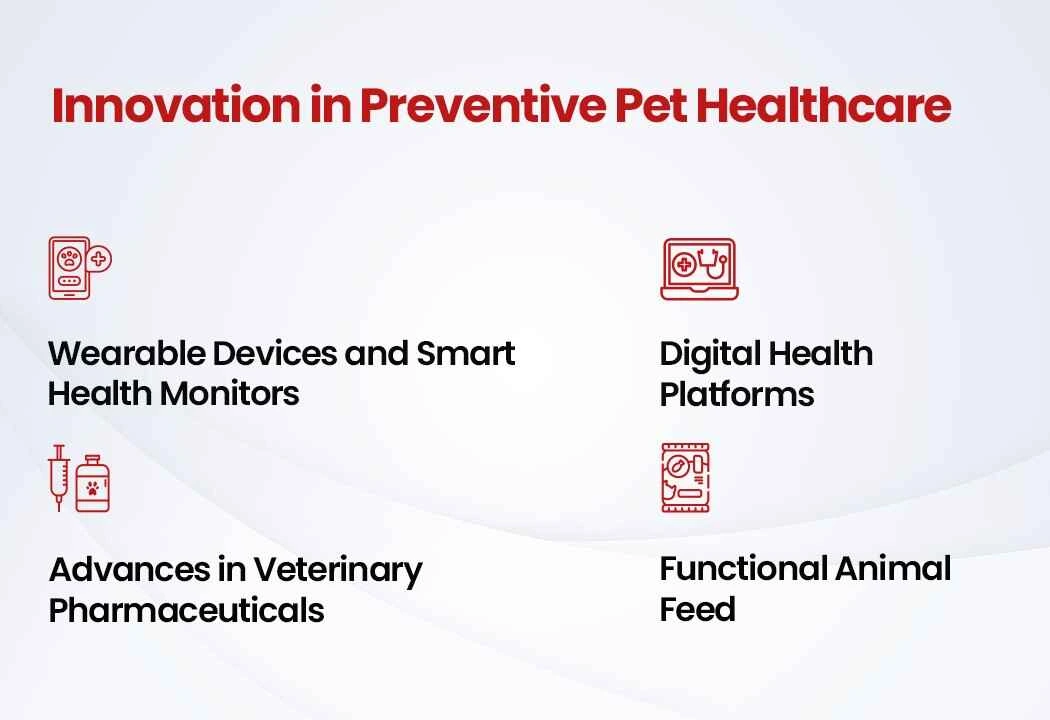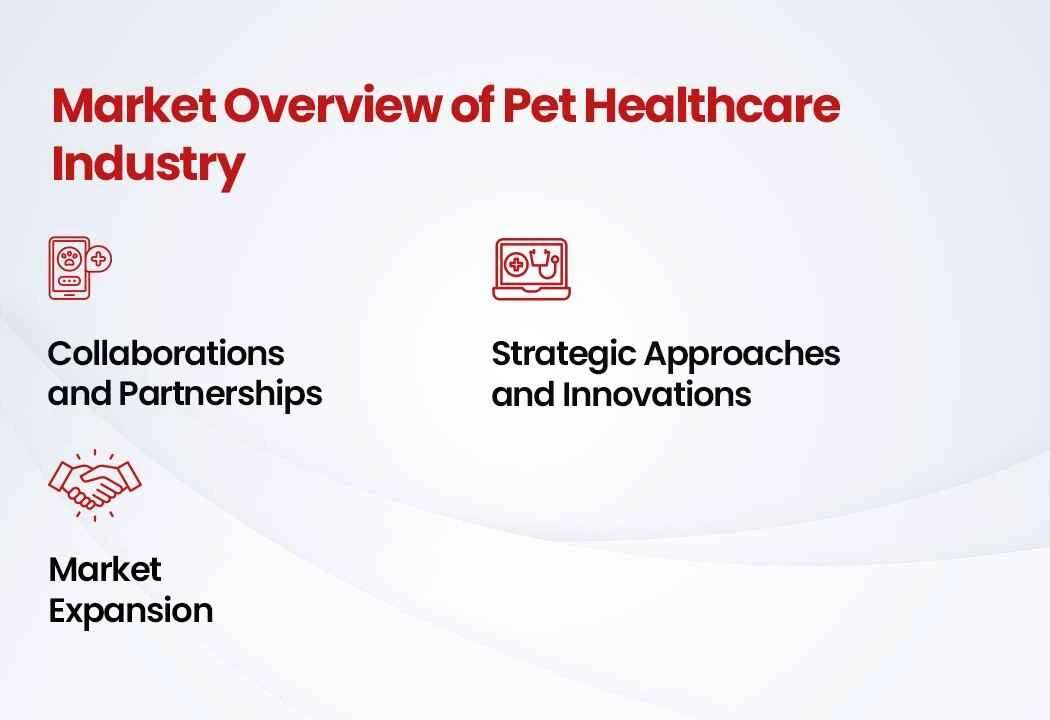Introduction
Preventive healthcare for pets has evolved significantly over the past few decades, reflecting broader trends in pet ownership and veterinary medicine. Today, the focus is not only on treating illnesses but also on preventing them, ensuring pets lead longer, healthier, and happier lives.
This shift towards preventive care is driven by various factors, including the increasing humanization of pets, technological advancements, and a deeper understanding of pet health needs.
Table of Contents
Market Overview
Global Market Size and Growth
The global market for preventive pet healthcare is experiencing substantial growth. In 2023, the market was valued at approximately $239.29 billion and is expected to reach $605.96 billion by 2032, with a compound annual growth rate (CAGR) of 10.3%.
This growth is driven by several factors, including the increasing trend of pet humanization, where pets are treated as family members, leading to higher spending on their health and well-being.
Advances in veterinary practices and a heightened focus on preventive care are also significant contributors. Additionally, economic prosperity and changes in regulatory frameworks have facilitated market expansion.
Regional Market Insights
-
North America
-
Europe
-
Asia-Pacific
-
Latin America and Middle East & Africa
Key Market Drivers
- Pet Humanization: Pet owners are increasingly treating pets as family members, leading to higher spending on their health and preventive care.
- Technological Advancements: Innovations such as wearable health monitoring devices and telemedicine are enhancing preventive care capabilities.
- Economic Trends: Rising disposable incomes and economic growth in various regions are enabling pet owners to invest more in healthcare products and services.
Leverage our market research services to gain a competitive edge in your industry!
Innovation in Preventive Pet Healthcare
1. Wearable Devices and Smart Health Monitors
The integration of wearable technology in pet healthcare has revolutionized the way pet health is monitored and managed. Devices such as smart collars and tags equipped with sensors can track a pet’s activity levels, location, vital signs, and behavior patterns.
These technologies provide pet owners and veterinarians with real-time data, enabling early detection of health issues and more proactive care.
- PetPace: A health monitoring platform using wearable technology to track vital signs such as temperature, pulse, and respiration, providing real-time alerts to pet owners and veterinarians.
- LinkVet: A collar-mounted device that tracks activity, location, and health, recently expanded through a partnership with MWI/AmerisourceBergen for wider distribution.
AI and Data Analytics Artificial intelligence (AI) and data analytics are becoming integral in diagnosing and monitoring pet health. AI algorithms can analyze health data to predict potential health issues and provide insights into optimal care practices.
This technology enhances diagnostic accuracy and treatment planning, leading to better health outcomes for pets.
- Medivel Bio: Uses advanced AI algorithms to diagnose companion animal skin diseases with high precision.
- Zoonivet: A digital platform by Cargill offering e-consultations, leveraging AI to facilitate remote veterinary care.
2. Digital Health Platforms
Digital health platforms are transforming preventive pet healthcare by making veterinary services more accessible and efficient. These platforms offer telemedicine services, digital health records, and continuous health data access, enabling pet owners to manage their pets’ health more effectively.
- Practo: An example from human healthcare, providing a comprehensive digital platform for consultations, appointments, and health record management.
- Vetster: Similar platforms are emerging in the pet healthcare space, offering telemedicine and health monitoring services.
3. Advances in Veterinary Pharmaceuticals
The pharmaceutical sector is seeing significant innovations aimed at improving preventive care for pets. New medications and treatments are being developed to address common pet health issues more effectively.
- Pharmaceutical Innovations: The development of new drugs targeting specific pet health problems, such as personalized healthcare plans and preventive dental care, is on the rise.
4. Functional Animal Feed
Functional ingredients in animal feed, such as probiotics, prebiotics, and enzymes, are designed to provide additional health benefits beyond basic nutrition, supporting overall pet health and disease prevention.
- Nutreco and BiomEdit: Strategic partnerships focusing on developing innovative feed additives through microbiome technology.
- BASF and Cargill: Collaborations to develop enzyme-based solutions aimed at improving animal health and promoting sustainable practices.

Challenges in Preventive Pet Healthcare
- High Costs of Advanced Treatments: One of the primary challenges in preventive pet healthcare is the high cost associated with advanced treatments and technologies.
As veterinary practices incorporate cutting-edge technologies and treatments, the costs for pet owners can become prohibitive. This financial barrier limits access to comprehensive preventive care, especially for owners in lower-income brackets.
- Rising Veterinary Costs: The cost of veterinary care has been rising due to advancements in medical treatments and technology. This includes the cost of diagnostic procedures, surgeries, and medications, making it challenging for some pet owners to afford necessary care.
- Regional Disparities in Access to Care: Access to veterinary care and preventive services can vary significantly between regions, with rural and underdeveloped areas often lacking sufficient veterinary infrastructure.
This disparity affects the availability and quality of preventive care services that pets receive.
- Infrastructure Challenges: In many rural and underdeveloped regions, the lack of veterinary clinics and healthcare professionals limits access to necessary preventive care services.
This results in a lower quality of care for pets in these areas compared to urban settings.
Research Directions and Future Trends
Emerging Research Areas
- Genetic and Genomic Studies: Advancements in genetic and genomic research are playing a pivotal role in preventive pet healthcare. Studies focusing on the genetic predispositions of pets to certain diseases can lead to more effective preventive measures and treatments.
By understanding the genetic makeup of pets, veterinarians can develop personalized healthcare plans that target specific health risks.
- Vaccine Research: Recent innovations include vaccines for diseases that have become more prevalent due to changing environmental conditions and increased travel of pets with their owners. Research is also focused on improving the efficacy and safety of existing vaccines.
- Nutritional Science and Functional Foods: Research in nutritional science is leading to the development of functional foods that provide health benefits beyond basic nutrition.
These foods are formulated with specific ingredients that support various aspects of pet health, such as immune function, digestion, and cognitive health.
Predicted Trends
- Increasing Adoption of Wearable Health Technology: The use of wearable technology for health monitoring is expected to become more widespread.
These devices provide continuous health data, allowing for early detection of potential health issues and more proactive management of pet health. - Telemedicine and Remote Veterinary Services: Telemedicine is set to play a significant role in the future of veterinary care, providing pet owners with easier access to veterinary services.
Remote consultations can help address minor health issues and follow-up care, making veterinary services more accessible and convenient. - Mental Health Innovations: Products designed to improve mental health, such as anxiety-reducing wearables and enrichment toys, are expected to become more popular. Additionally, research into the impact of environmental enrichment on pet behavior and well-being is likely to increase.
Solutions Across Different Jurisdictions
United States
The U.S. leads in preventive pet healthcare with advanced veterinary infrastructure, widespread adoption of pet insurance, and a strong focus on research and innovation.
The North American Pet Health Insurance Association (NAPHIA) reports that over 5.36 million pets were insured in 2022, reflecting a 21.7% increase from the previous year.
This insurance coverage encourages more frequent veterinary visits and preventive treatments, improving overall pet health outcomes.
- Regulatory Framework: The U.S. has a well-established regulatory framework for veterinary products and services, ensuring high standards of care.
Organizations like the American Veterinary Medical Association (AVMA) provide guidelines and standards that promote preventive healthcare practices.
Europe
Europe shows significant growth in preventive pet healthcare, driven by strong veterinary infrastructure and a high number of pet owners. Germany, for example, has the second-highest population of pet cats in Europe, with 16.7 million cats, and a substantial number of pet dogs as well.
The European Pet Food Industry Federation (FEDIAF) highlights that an 11% growth in the pet population in 2022 underscores the increasing demand for preventive care products and services.
- EU Regulations: The European Commission has initiatives like the Feed Additives Regulation to modernize the market and introduce innovative feed ingredients.
This regulatory approach supports the development and availability of advanced preventive care products.
Asia-Pacific
The Asia-Pacific region is experiencing rapid growth in preventive pet healthcare, driven by increasing pet ownership and rising awareness about pet health.
Countries like China, Japan, and India are witnessing a surge in the adoption of digital health platforms and preventive care practices.
- Innovative Solutions: Companies in this region are investing in digital health technologies and wearable devices to enhance preventive care.
The focus is also on developing affordable and accessible healthcare solutions to cater to the diverse economic landscape.
Latin America
Latin America, particularly Brazil, has a large pet population, driving the demand for preventive healthcare products. The region is focusing on improving access to veterinary services and promoting preventive care through community outreach and educational programs.
- Community Initiatives: Efforts to increase awareness about preventive care and improve access to veterinary services in underserved areas are key strategies in Latin America.
These initiatives aim to bridge the gap in healthcare access and enhance overall pet health.
Middle East and Africa
The Middle East and Africa are gradually improving in preventive pet healthcare, with a growing awareness of hygiene and preventive care. The region is focusing on addressing economic disparities and enhancing the availability of preventive care products.
- Economic and Cultural Challenges: Efforts are being made to overcome economic barriers and cultural differences that impact the adoption of preventive healthcare practices.
Educational programs and community initiatives are crucial in promoting awareness and improving access to care.
Market Overview of Pet Healthcare Industry
Collaborations and Partnerships
- Nutreco and BiomEdit: These companies have partnered to develop innovative feed additives through microbiome technology.
Their focus is on creating functional feeds that provide health benefits beyond basic nutrition, contributing to preventive pet healthcare.
- BASF and Cargill BASF: and Cargill have expanded their partnership to develop enzyme-based solutions for the animal feed industry.
These solutions aim to improve animal health, reduce environmental impact, and promote sustainable practices in pet care.
Strategic Approaches and Innovations
Leading companies in the pet healthcare market continuously develop and launch new products to meet the evolving needs of pet owners. Innovations in pet food, pharmaceuticals, and health monitoring technologies are central to their strategies.
- Mars and Nestle Purina: Both companies are heavily involved in developing new pet food products that address specific health concerns, such as weight management, dental health, and digestive health.
- Zoetis and Elanco: These companies focus on pharmaceutical innovations, creating new vaccines and treatments to prevent common pet diseases and improve overall health outcomes.
Market Expansion
Companies are also expanding their market reach through strategic acquisitions and partnerships. This approach helps them tap into new markets and offer a broader range of products and services to pet owners.
- Mars’ Acquisition of Champion Pet Foods: This strategic move has expanded Mars’ product portfolio and enhanced its market position.
- Zoetis and Elanco: Both companies are expanding their presence globally, focusing on regions with growing pet populations and increasing demand for preventive care.

Conclusion
The preventive pet healthcare market is rapidly evolving, driven by technological advancements, increasing pet humanization, and a focus on holistic well-being.
Wearable devices, AI, and digital health platforms are transforming how pet health is monitored and managed, making preventive care more accessible and efficient.
About TTC
At TT Consultants, we're a premier provider of custom intellectual property (IP), technology intelligence, business research, and innovation support. Our approach blends AI and Large Language Model (LLM) tools with human expertise, delivering unmatched solutions.
Our team includes skilled IP experts, tech consultants, former USPTO examiners, European patent attorneys, and more. We cater to Fortune 500 companies, innovators, law firms, universities, and financial institutions.
Services:
- Patentability Search
- Invalidation Search
- Freedom to Operate (FTO) Analysis
- Patent Portfolio Management
- Patent Infringement Searches
- Drafting & Illustrations
- Competitive Benchmarking
- Technology Scouting
- Landscape Analysis
- Whitespace Analysis
- Business Research
Choose TT Consultants for tailored, top-quality solutions that redefine intellectual property management.
Contact UsTalk To Our Expert
Contact us now to schedule a consultation and start shaping your patent invalidation strategy with precision and foresight.





